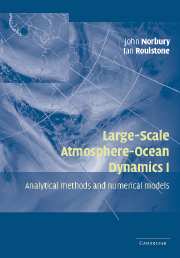Book contents
- Frontmatter
- Contents
- Contributors
- Preface
- Introduction and Scientific Background
- 1 A view of the equations of meteorological dynamics and various approximations
- 2 Extended-geostrophic Euler–Poincaré models for mesoscale oceanographic flow
- 3 Fast singular oscillating limits of stably-stratified 3D Euler and Navier–Stokes equations and ageostrophic wave fronts
- 4 New mathematical developments in atmosphere and ocean dynamics, and their application to computer simulations
- 5 Rearrangements of functions with applications to meteorology and ideal fluid flow
- 6 Statistical methods in atmospheric dynamics: probability metrics and discrepancy measures as a means of defining balance
4 - New mathematical developments in atmosphere and ocean dynamics, and their application to computer simulations
Published online by Cambridge University Press: 04 February 2010
- Frontmatter
- Contents
- Contributors
- Preface
- Introduction and Scientific Background
- 1 A view of the equations of meteorological dynamics and various approximations
- 2 Extended-geostrophic Euler–Poincaré models for mesoscale oceanographic flow
- 3 Fast singular oscillating limits of stably-stratified 3D Euler and Navier–Stokes equations and ageostrophic wave fronts
- 4 New mathematical developments in atmosphere and ocean dynamics, and their application to computer simulations
- 5 Rearrangements of functions with applications to meteorology and ideal fluid flow
- 6 Statistical methods in atmospheric dynamics: probability metrics and discrepancy measures as a means of defining balance
Summary
Introduction
This chapter reviews new developments in the mathematical theory of the partial differential equations which govern the large scale behaviour of the atmosphere and ocean. It then discusses how these can be applied to the models which are used to predict weather and climate, and to define the initial state of the atmosphere or ocean from limited observations. Particular topics include: (i) the use of Lagrangian conservation properties in establishing the existence of solutions to, and properties of, simpler equations which describe the atmosphere and ocean in the limits of rapid rotation and/or strong stratification; (ii) demonstrations that the complete equations can be proved to have solutions close to those of the simpler equations in these asymptotic limits; and (iii) how the statistical effect of small scale motions interacts with the large scale solutions. It is demonstrated how these techniques can be exploited in the design of computer models suitable for operational applications, including numerical methods for representing the resolved dynamics and the coupling of sub-grid models to the resolved dynamics. The latter is particularly important where moisture has a strong influence on the dynamics. These techniques can also be used to exploit observed data more fully by improving the design of data assimilation systems. In particular, they can also be used to refine estimates of error growth. These are important in data assimilation, where model errors have to be allowed for and corrected, and in predictability studies.
- Type
- Chapter
- Information
- Large-Scale Atmosphere-Ocean DynamicsAnalytical Methods and Numerical Models, pp. 202 - 287Publisher: Cambridge University PressPrint publication year: 2002
- 3
- Cited by



